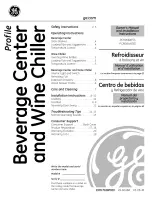
19
• Use the wine cellar only to store wines and do
not put any other type of food into it.
• Be careful not to cover or obstruct the
appliance’s ventilation openings.
To avoid the risk of suffocation and becoming
trapped, do not allow children to play or hide
inside the appliance.
• Before any maintenance or cleaning, unplug
the plug from the power socket or switch off
the electrical power.
• Only an authorised person can replace the
power supply cable.
• Do not keep explosive substances in the
appliance.
• Be careful when moving the appliance not to
damage flooring (e.g. parquet).
• Do not use extensions or multiple adapters.
• The appliance is not intended for use by young
children or unsupervised infirm people.
• Do not damage the cooling fluid circuit.
• Do not use electrical appliances inside the
wine cellar, if they are not of the type
recommended by the manufacturer.
• Place the appliance in a dry and well-ventilated
room. The appliance is designed to work in
rooms where the temperature falls within the
following intervals, which in turn are a function
of the climatic class given on the data plate:
the appliance may not work correctly if it is
left for a long time at a temperature higher or
lower than the interval specified.
Important:
• If large amounts of wine are put in the
appliance, it may take several days for it to
reach a constant temperature.
• Caution! The storage temperature must never
drop below +6°C.
• When the appliance is working, drops of dew
or frost may form on the inner liner wall. This
depends on the operation. There is no need
to scrape the frost off or dry off the dew. The
back wall defrosts automatically. The defrost
water is automatically conveyed to a drain
hole, and then collected in a container where
it evaporates.
• The bottles can be stored neatly on the
wooden racks. Each shelf can bear a maximum
weight of 40 Kg.
Remember when arranging
• Place the bottles in a central position on the
rack.
• When closing the door make sure that the
bottles do not touch the glass door.
• Caution: highly concentrated alcohol must be
kept hermetically closed and in a vertical
position.
• Because of the circulation of air in the
refrigerator, different temperature zones
form:
The colder zones are those near the back wall,
the warmer zones are close to the door glass.
• Always store bottled wines individually and
not in cases or cardboard boxes.
GENERAL PRECAUTIONS AND
SUGGESTIONS
Climatic Class Room T. (°C) Room T (°F)
SN
from 10 to 32 from 50 to 90
N
from 16 to 32 from 61 to 90
ST
from 16 to 38 from 61 to 100
T
from 16 to 43 from 61 to 110
Summary of Contents for ARC 229
Page 12: ...29 555 INSTALLATION ...






























